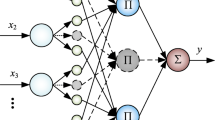Abstract
In this paper, we introduce a concept of advanced self-organizing polynomial neural network (Adv_SOPNN). The SOPNN is a flexible neural architecture whose structure is developed through a modeling process. But the SOPNN has a fatal drawback; it cannot be constructed for nonlinear systems with few input variables. To relax this limitation of the conventional SOPNN, we combine a fuzzy system and neural networks with the SOPNN. Input variables are partitioned into several subspaces by the fuzzy system or neural network, and these subspaces are utilized as new input variables to the SOPNN architecture. Two types of the advanced SOPNN are obtained by combining not only the fuzzy rules of a fuzzy system with SOPNN but also the nodes in a hidden layer of neural networks with SOPNN into one methodology. The proposed method is applied to the nonlinear system with two inputs, which cannot be identified by conventional SOPNN to show the performance of the advanced SOPNN. The results show that the proposed method is efficient for systems with limited data set and a few input variables and much more accurate than other modeling methods with respect to identification error.










Similar content being viewed by others
References
Kim DW (2002) Evolutionary design of self-organizing polynomial neural networks, Master’s thesis, Department Control Instruments Wonkwang University
Oh SK, Pedrycz W (2002) The design of self-organizing polynomial neural networks. Inf Sci 141:237–258
Oh SK, Kim DW, Park BJ (2000) A study on the optimal design of polynomial neural networks structure. Trans KIEE 49D, No. 3
Jang JS (1993) ANFIS: Adaptive-networks-based fuzzy inference system. IEEE Trans Syst Man Cybern 23(3):665–685
Takagi T, Sugeno M (1985) Fuzzy identification of systems and its applications to modeling and control. IEEE Trans Syst Man Cybern 15:116–132
Sugeno M, Yasukawa T (1993) A fuzzy-logic-based approach to qualitative modeling. IEEE Trans Fuzzy Syst 1(1):7–31
Freeman J, Skapura D (1991) Neural networks. Addison-Wesley, New York
Kodogiannis V, Lolis A (2002) Forecasting financial time series using neural network and fuzzy system-based techniques. Neural Comput Appl 11:90–102
Takagi H, Hayashi I (1991) NN-driven fuzzy reasoning. Int J Approx Reasoning 5(3):191–212
Funahashi KI (1989) On the approximate realization of continuous mappings by neural networks. Neural Netw 2:183–192
Ivakhnenko AG, Krotov GI, Ivakhnenko NA (1970) Identification of the mathematical model of a complex system by the self-organization method. In: Halfon E (ed) Theoretical systems ecology: advances and case studies, chap 13. Academic, New York
Farlow SJ (1984) Self-organizing methods in modeling, GMDH type-algorithms. Marcel Dekker, New York
Freeman J, Skapura D (1991) Neural networks. Addison-Wesley, New York
Fakhr-Eddine K, Cabassud M, Le Lann MV, Couderc JP (2000) Neural network structures for optimal control of LPCVD reactors. Neural Comput Appl 9:172–180
Kim ET, Park MK, Ji SH, Park M (1997) A new approach to fuzzy modeling. IEEE Trans Fuzzy Syst 5(3):328–337
Kim E, Lee H, Park M, Park M (1998) A simply identified Sugeno-type fuzzy model via double clustering. Inf Sci 110:25–39
Gomez-Skarmeta AF, Delgado M, Vila MA (1999) About the use of fuzzy clustering techniques for fuzzy model identification. Fuzzy Sets Syst 106:179–188
Hwang HS, Woo KB (1995) Linguistic fuzzy model identification, IEE Proceedings-Control Theory Appl:142(6)
Lin Y, Cunningham III GA (1995) A new approach to fuzzy-neural system modeling. IEEE Trans Fuzzy Syst 3(2):190–198
Kim DW, Oh SK, Kim HK (2001) A study on the self-organizing fuzzy polynomial neural networks. J KIEE 11(2):79–89
Acknowledgments
The authors thank the financial support of the Korea Science & Engineering Foundation. This work was supported by grant No. R01-2005-000-11044-0 from the Basic Research Program of the Korea Science & Engineering Foundation. The authors are also very grateful to the anonymous reviewers for their valuable comments.
Author information
Authors and Affiliations
Corresponding authors
Rights and permissions
About this article
Cite this article
Kim, D., Park, GT. Advanced self-organizing polynomial neural network. Neural Comput & Applic 16, 443–452 (2007). https://doi.org/10.1007/s00521-006-0070-x
Received:
Accepted:
Published:
Issue Date:
DOI: https://doi.org/10.1007/s00521-006-0070-x




